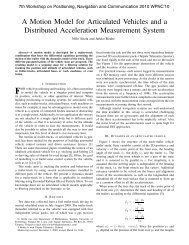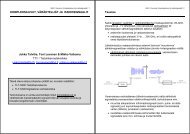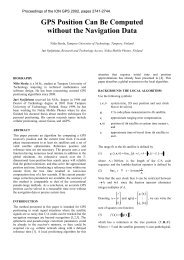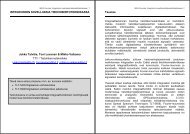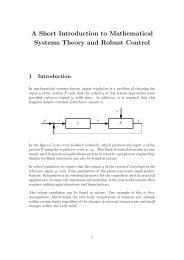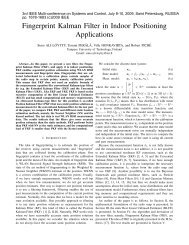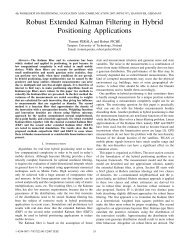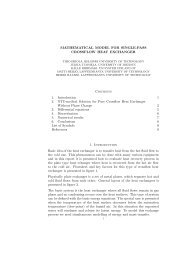Antti Lehtinen Doppler Positioning with GPS - Matematiikan laitos
Antti Lehtinen Doppler Positioning with GPS - Matematiikan laitos
Antti Lehtinen Doppler Positioning with GPS - Matematiikan laitos
You also want an ePaper? Increase the reach of your titles
YUMPU automatically turns print PDFs into web optimized ePapers that Google loves.
4.5 Standard Numerical Methods<br />
In this section, a new algorithm is developed for the <strong>GPS</strong> <strong>Doppler</strong> positioning.<br />
The algorithm is based on well known ideas from the numerical analysis. However,<br />
the method has not earlier been applied to the <strong>GPS</strong> <strong>Doppler</strong> positioningproblem.<br />
4.5.1 Problem Formulation<br />
In the following, we will consider iterative methods that begin from an initial<br />
guess for the solution and continue to gradually enhance the estimate.<br />
Notation 1. The receiver position and drift estimate<br />
⎡ ⎤<br />
ˆxu<br />
<br />
ˆru ⎢ ˆyu ⎥<br />
ˆx =<br />
ˆd<br />
= ⎢ ⎥<br />
⎣ ˆzu ⎦ ∈ R4<br />
ˆd<br />
is the current estimate for the receiver position and drift vector x<br />
Notation 2. The delta range measurement vector<br />
˙ρ =[˙ρ1 ˙ρ2 ... ˙ρn] T<br />
is a vector formed of the delta range measurements from the n satellites used in<br />
the calculations.<br />
The equation 4.13 gives a physical model for the delta range measurements. Assumingthat<br />
the noise components ɛ ˙ρi are zero-mean gives rise to the following<br />
definition:<br />
Definition 2. The expected delta range vector<br />
⎡<br />
⎢<br />
ˆ˙ρ = ⎢<br />
⎣<br />
v1 • r1 − ˆru<br />
r1 − ˆru + ˆ d<br />
v2 • r2 − ˆru<br />
r2 − ˆru + ˆ d<br />
.<br />
vn • rn − ˆru<br />
rn − ˆru + ˆ d<br />
is the expected delta range measurement vector assuming the receiver to be located<br />
at ˆru and the clock drift to be ˆ d.<br />
The positioningsolution procedure should aim at findinga point ˆx such that<br />
the expected delta range measurement vector would be equal to the real delta<br />
range measurement vector, that is ˆ˙ρ = ˙ρ. In order to have the problem in a<br />
mathematically standard form we will define the followinghelpful function:<br />
24<br />
⎤<br />
⎥<br />
⎦




